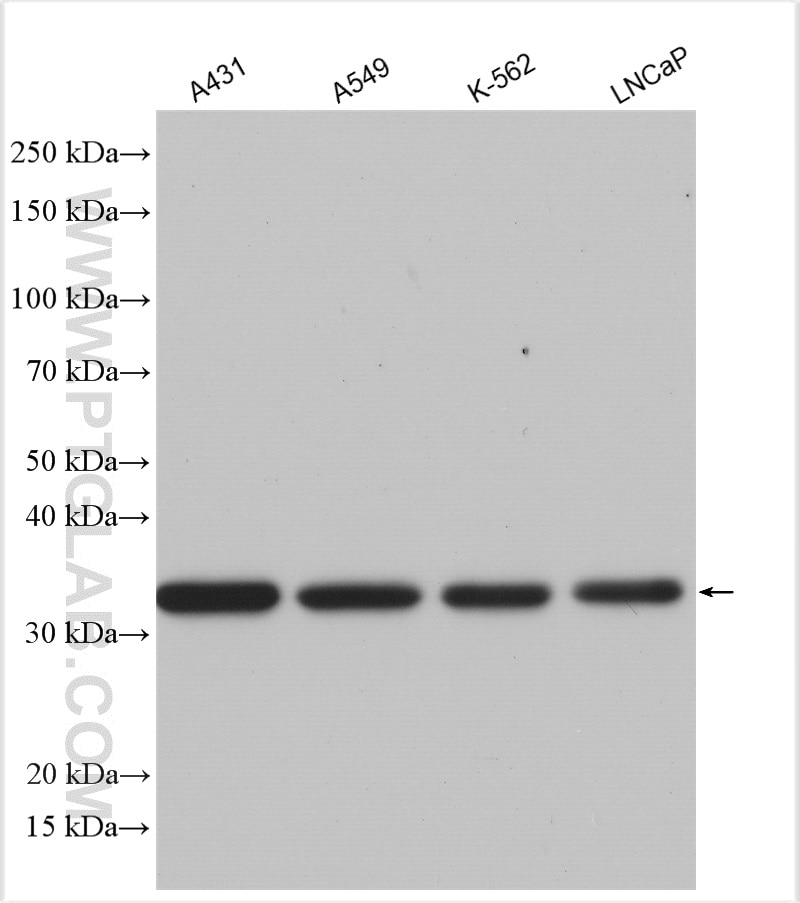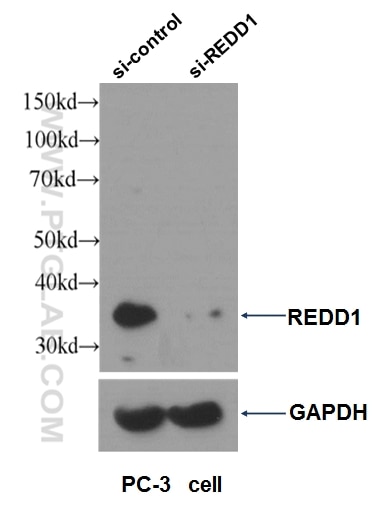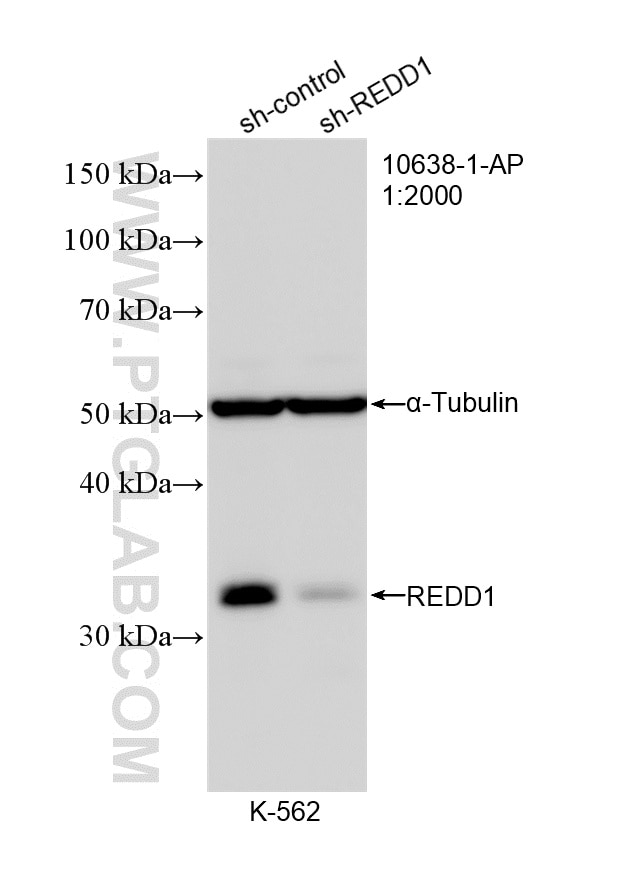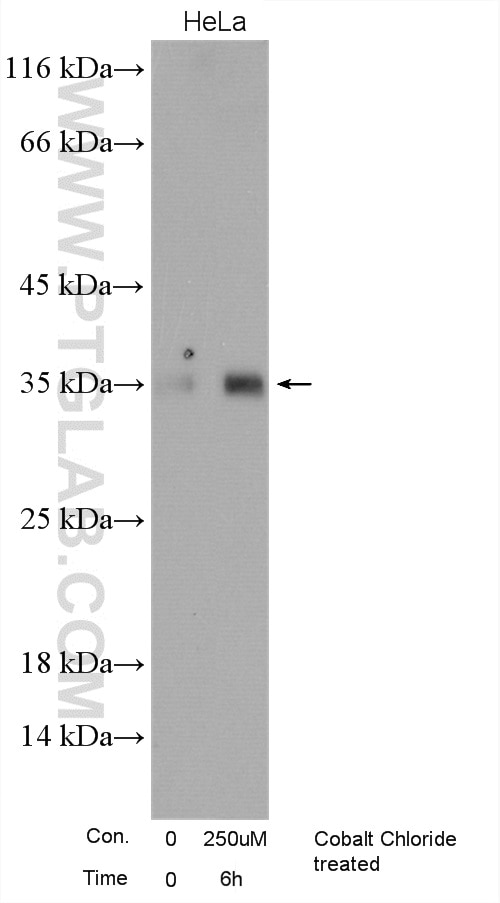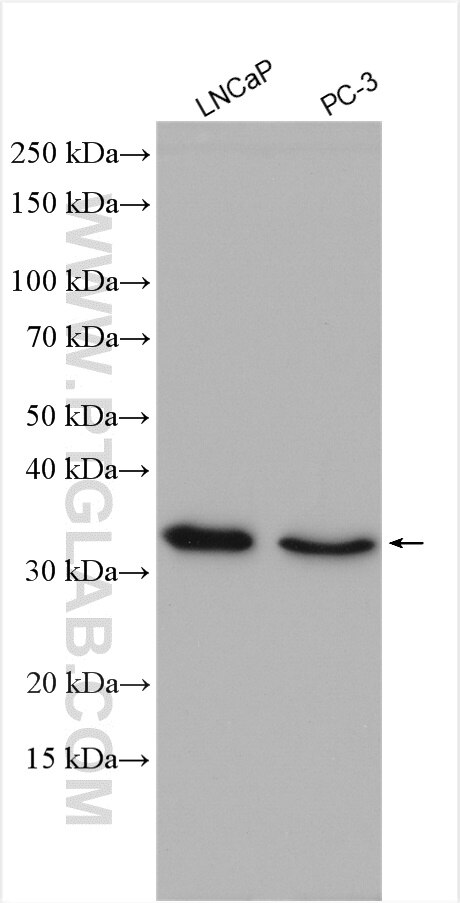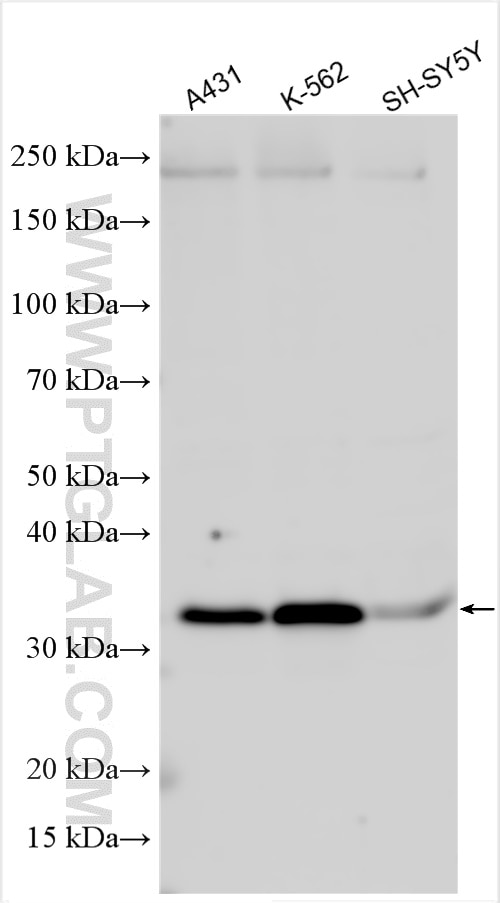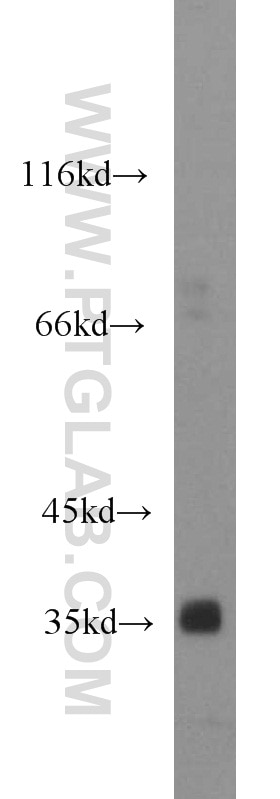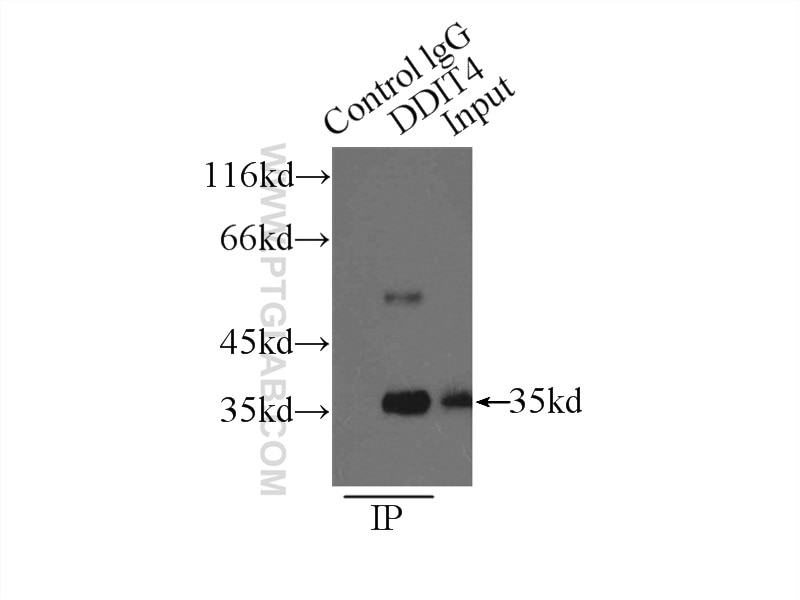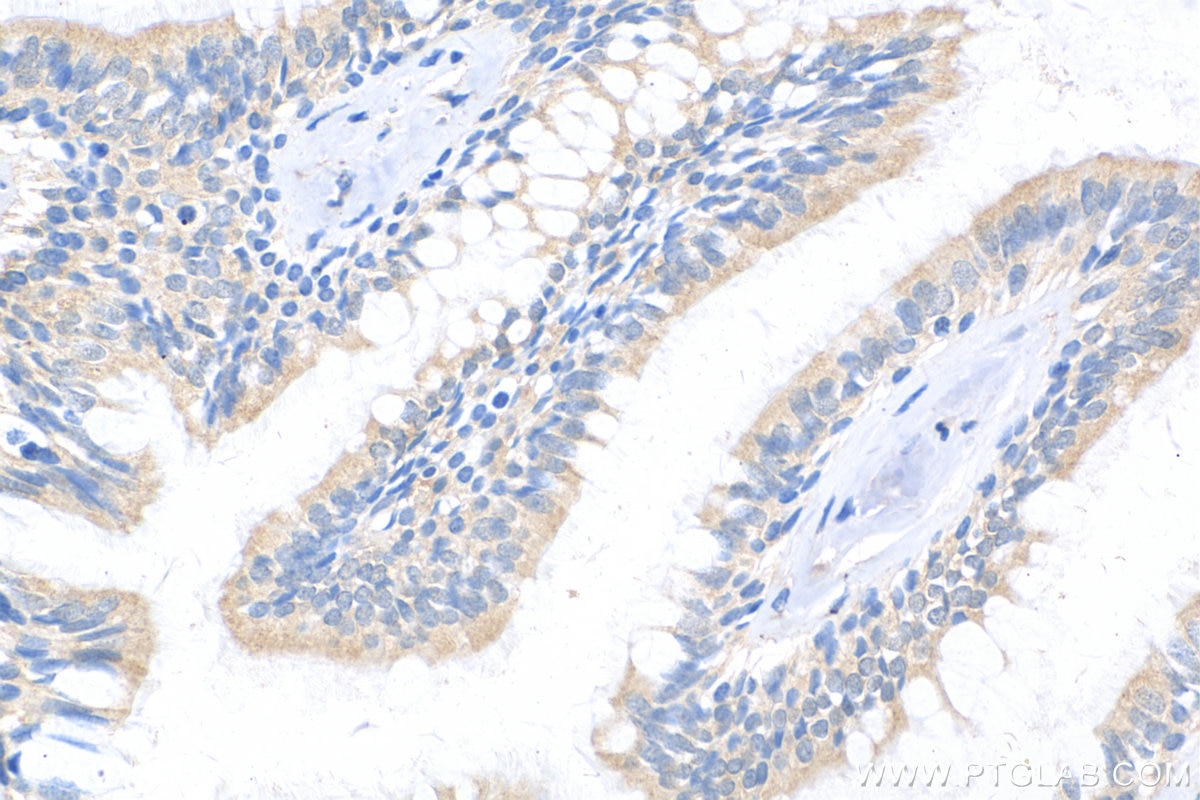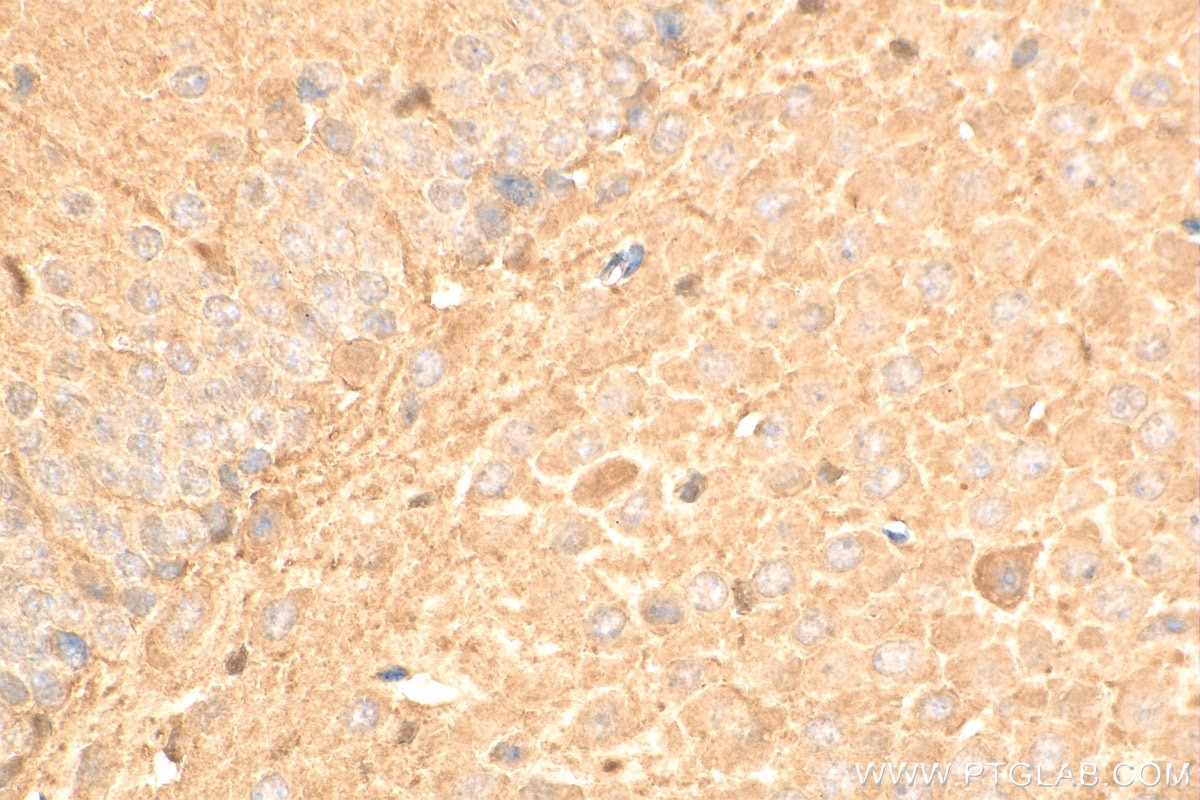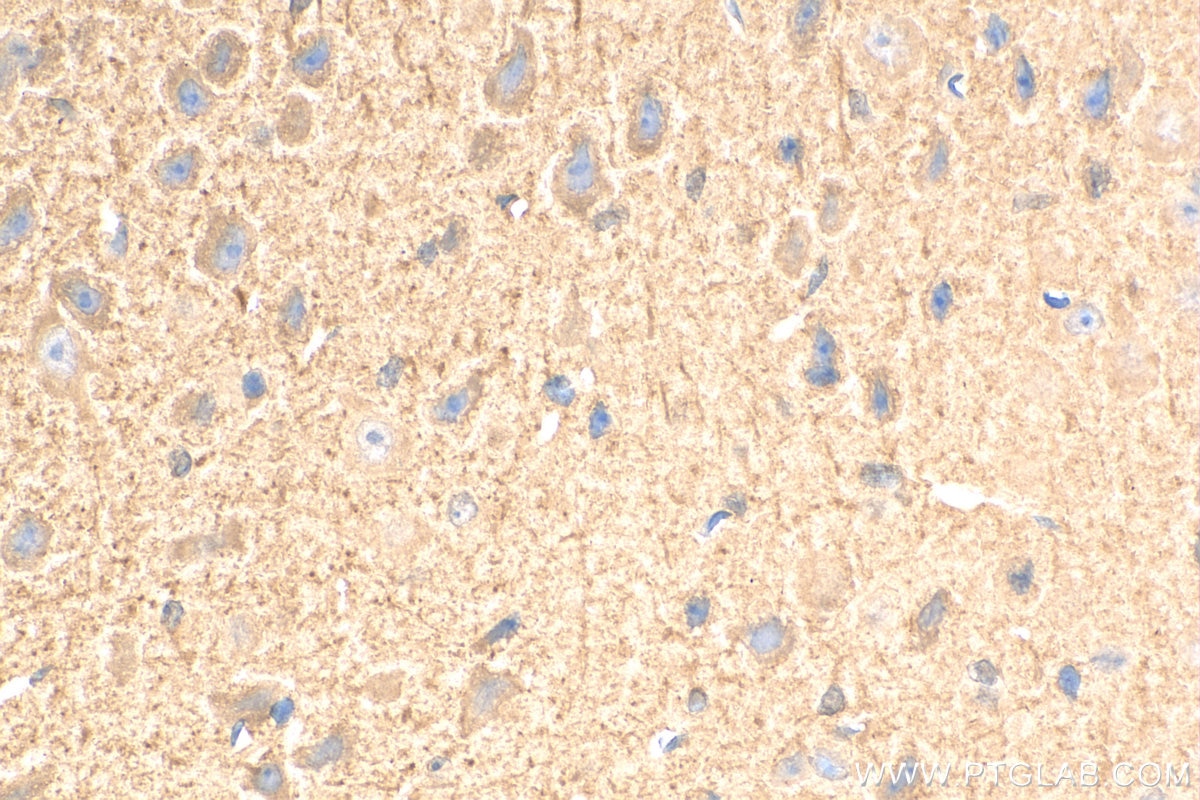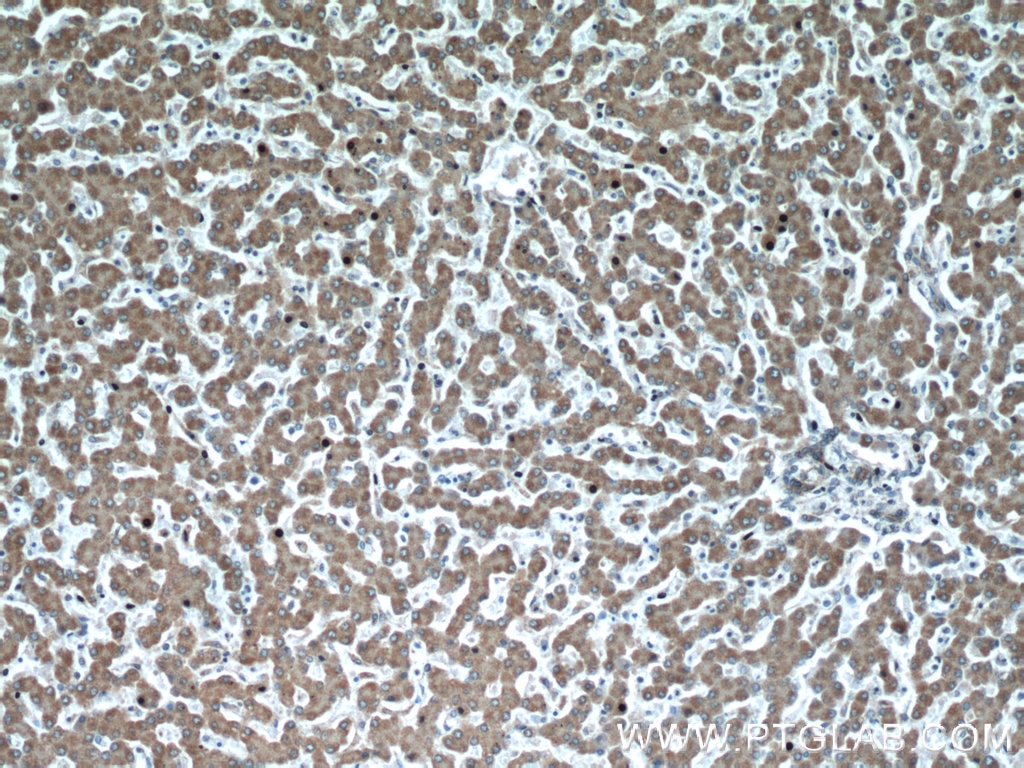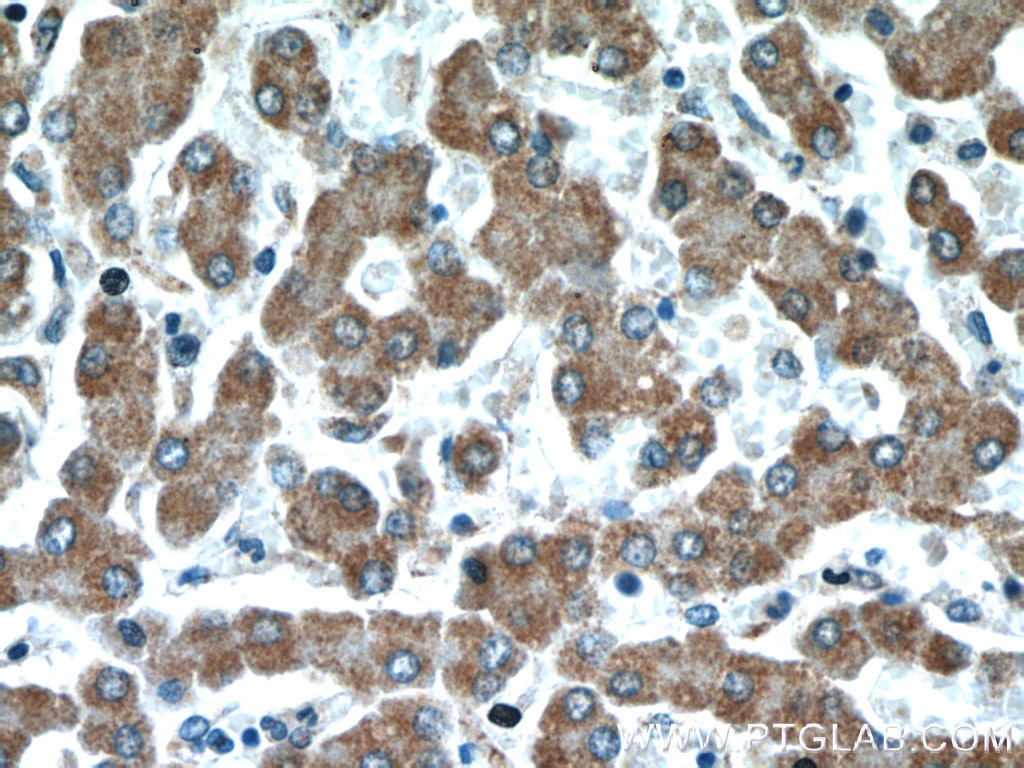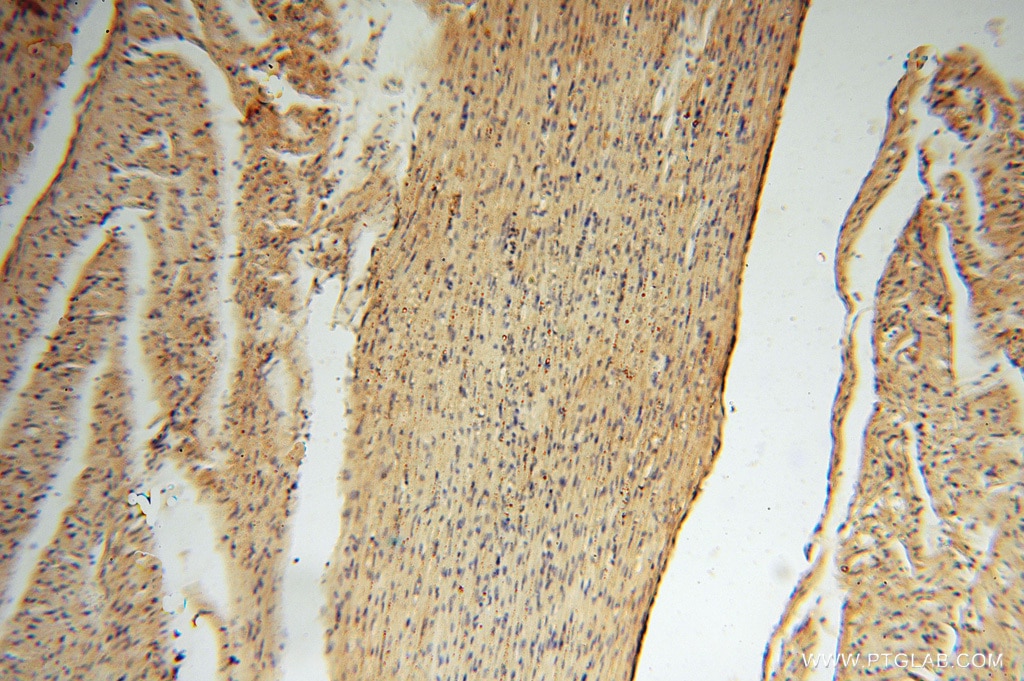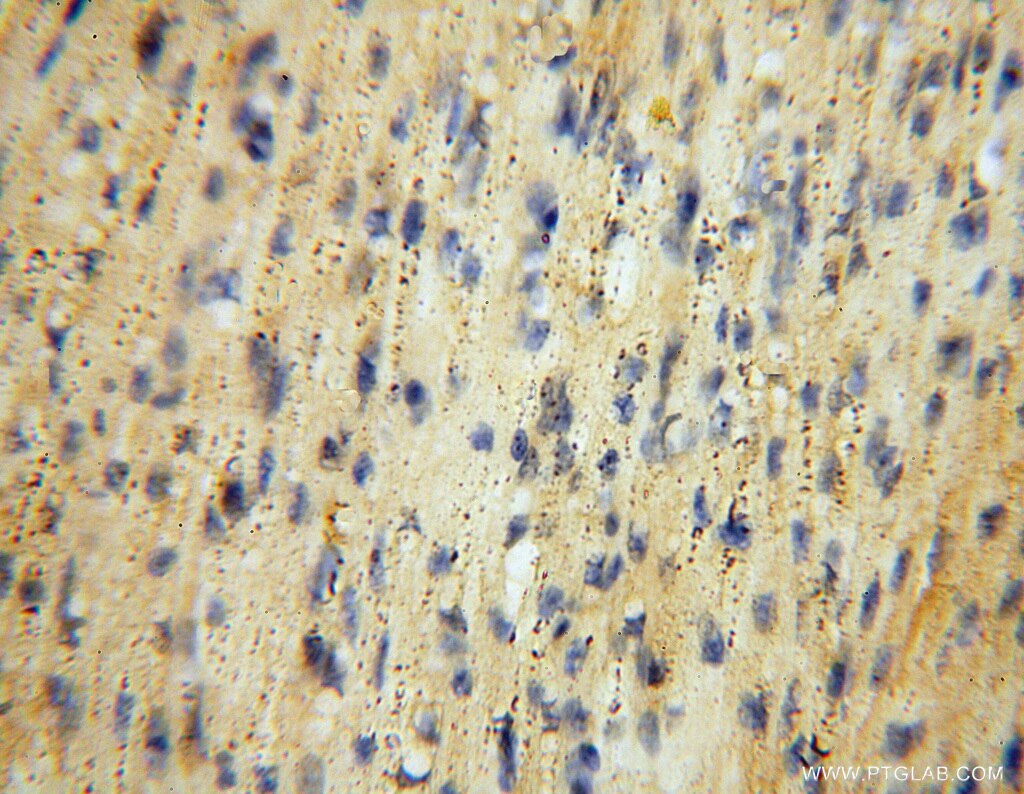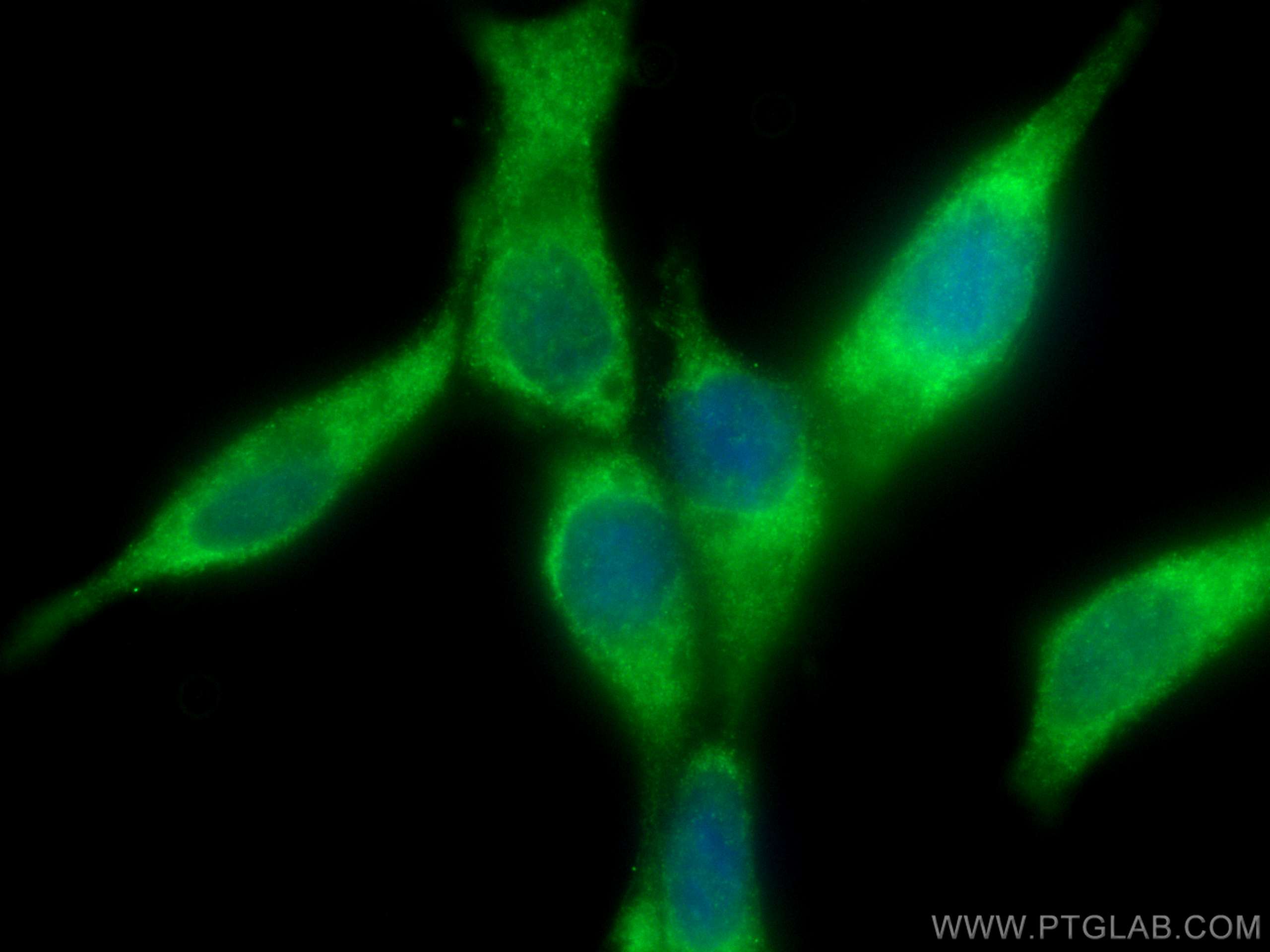- Featured Product
- KD/KO Validated
REDD1 specific Polyklonaler Antikörper
REDD1 specific Polyklonal Antikörper für WB, IHC, IF/ICC, IP, ELISA
Wirt / Isotyp
Kaninchen / IgG
Getestete Reaktivität
human, Maus und mehr (5)
Anwendung
WB, IHC, IF/ICC, IP, CoIP, chIP, ELISA
Konjugation
Unkonjugiert
Kat-Nr. : 10638-1-AP
Synonyme
Geprüfte Anwendungen
| Erfolgreiche Detektion in WB | A431-Zellen, A549-Zellen, mit Cobaltchlorid behandelte HeLa-Zellen, DU 145-Zellen, K-562-Zellen, LNCaP-Zellen, PC-3-Zellen, SH-SY5Y-Zellen |
| Erfolgreiche IP | MCF-7-Zellen |
| Erfolgreiche Detektion in IHC | humanes Lungenkarzinomgewebe, humanes Herzgewebe, humanes Lebergewebe Hinweis: Antigendemaskierung mit TE-Puffer pH 9,0 empfohlen. (*) Wahlweise kann die Antigendemaskierung auch mit Citratpuffer pH 6,0 erfolgen. |
| Erfolgreiche Detektion in IF/ICC | LNCaP-Zellen |
Empfohlene Verdünnung
| Anwendung | Verdünnung |
|---|---|
| Western Blot (WB) | WB : 1:2000-1:12000 |
| Immunpräzipitation (IP) | IP : 0.5-4.0 ug for 1.0-3.0 mg of total protein lysate |
| Immunhistochemie (IHC) | IHC : 1:50-1:500 |
| Immunfluoreszenz (IF)/ICC | IF/ICC : 1:200-1:800 |
| It is recommended that this reagent should be titrated in each testing system to obtain optimal results. | |
| Sample-dependent, check data in validation data gallery | |
Veröffentlichte Anwendungen
| KD/KO | See 38 publications below |
| WB | See 263 publications below |
| IHC | See 25 publications below |
| IF | See 18 publications below |
| IP | See 1 publications below |
| CoIP | See 3 publications below |
| ChIP | See 2 publications below |
Produktinformation
10638-1-AP bindet in WB, IHC, IF/ICC, IP, CoIP, chIP, ELISA REDD1 specific und zeigt Reaktivität mit human, Maus
| Getestete Reaktivität | human, Maus |
| In Publikationen genannte Reaktivität | human, Eichh?rnchen, Hausschwein, Kaninchen, Maus, Ratte, Mongolische Wüstenrennmaus (Gerbil) |
| Wirt / Isotyp | Kaninchen / IgG |
| Klonalität | Polyklonal |
| Typ | Antikörper |
| Immunogen | REDD1 specific fusion protein Ag0965 |
| Vollständiger Name | DNA-damage-inducible transcript 4 |
| Berechnetes Molekulargewicht | 25 kDa |
| Beobachtetes Molekulargewicht | 32-35 kDa |
| GenBank-Zugangsnummer | BC007714 |
| Gene symbol | REDD1/DDIT4 |
| Gene ID (NCBI) | 54541 |
| Konjugation | Unkonjugiert |
| Form | Liquid |
| Reinigungsmethode | Antigen-Affinitätsreinigung |
| Lagerungspuffer | PBS with 0.02% sodium azide and 50% glycerol |
| Lagerungsbedingungen | Bei -20°C lagern. Nach dem Versand ein Jahr lang stabil Aliquotieren ist bei -20oC Lagerung nicht notwendig. 20ul Größen enthalten 0,1% BSA. |
Hintergrundinformationen
REDD1, also named as RTP801 and DDIT4, belongs to the DDIT4 family. REDD1 promotes neuronal cell death. It is a novel transcriptional target of p53 implicated ROS in the p53-dependent DNA damage response. REDD1 controlled cell growth under energy stress, as an essential regulator of TOR activity through the TSC1/2 complex. REDD-1 expression has also been linked to apoptosis, Aβ toxicity and the pathogenesis of ischemic diseases. As an HIF-1-responsive gene, REDD-1 exhibits strong hypoxia-dependent upregulation in ischemic cells of neuronal origin[PMID: 19996311]. In response to stress due to DNA damage and glucocorticoid treatment, REDD-1 is upregulated at the transcriptional level[PMID: 21733849]. REDD-1 negatively regulates the mammalian target of Rapamycin, a serine/threonine kinase often referred to as mTOR[PMID: 22951983]. It is crucial in the coupling of extra- and intracellular cues to mTOR regulation. The absence of REDD-1 is associated with the development of retinopathy, a major cause of blindness[PMID: 22304497]. REDD1 is a new host defense factor, and chemical activation of REDD1 expression represents a potent antiviral intervention strategy[PMID: 21909097]. The calculated molecular weight of REDD1 is 25 kDa. Because of multiple lysines in the proteins, REDD1 offen migrates around 35 kDa on Western blot[PMID: 19221489]. This antibody is a rabbit polyclonal antibody raised against full length human REDD1 antigen. This antibody is specific to the REDD1 from siRNA experiment (PMID:24713927)
Protokolle
| PRODUKTSPEZIFISCHE PROTOKOLLE | |
|---|---|
| WB protocol for REDD1 specific antibody 10638-1-AP | Protokoll herunterladen |
| IHC protocol for REDD1 specific antibody 10638-1-AP | Protokoll herunterladenl |
| IF protocol for REDD1 specific antibody 10638-1-AP | Protokoll herunterladen |
| IP protocol for REDD1 specific antibody 10638-1-AP | Protokoll herunterladen |
| STANDARD-PROTOKOLLE | |
|---|---|
| Klicken Sie hier, um unsere Standardprotokolle anzuzeigen |
Publikationen
| Species | Application | Title |
|---|---|---|
Cell Metab Disrupted methionine cycle triggers muscle atrophy in cancer cachexia through epigenetic regulation of REDD1 | ||
Cancer Cell A UBE2O-AMPKα2 Axis that Promotes Tumor Initiation and Progression Offers Opportunities for Therapy. | ||
Nat Immunol The transcription factor Rfx7 limits metabolism of NK cells and promotes their maintenance and immunity. |
Rezensionen
The reviews below have been submitted by verified Proteintech customers who received an incentive for providing their feedback.
FH Yuki (Verified Customer) (11-10-2022) | This product was used for IHC in human tissue.
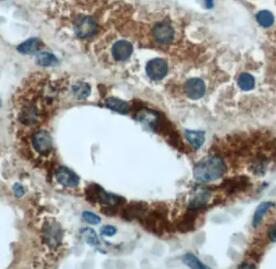 |
FH Stephane (Verified Customer) (11-26-2020) | The antibody performs great on human cell extract. It detects specific bands with the REDD1 band resolving around 30-35 kD.
 |
FH Jamal (Verified Customer) (09-17-2019) | This product was used for Western Blotting in mouse cortex tissue.
|
FH Bradley (Verified Customer) (08-19-2019) | I have used this antibody on numerous occasions with success. The antibody performs great on human cell extract, as evidenced by a single immunoreactive band. The antibody performs moderately well on mouse skeletal muscle extract as it detects many non-specific bands with the REDD1 band resolving around 32-35 kD (specificity determined using REDD1-/- samples). The antibody is capable of detecting large changes in REDD1 protein in mouse skeletal muscle (i.e. induction following dexamethasone treatment), but smaller changes are difficult to assess in this tissue. This antibody will detect smaller changes in human cell lines such as HEK 293 or Hela cells.
|
